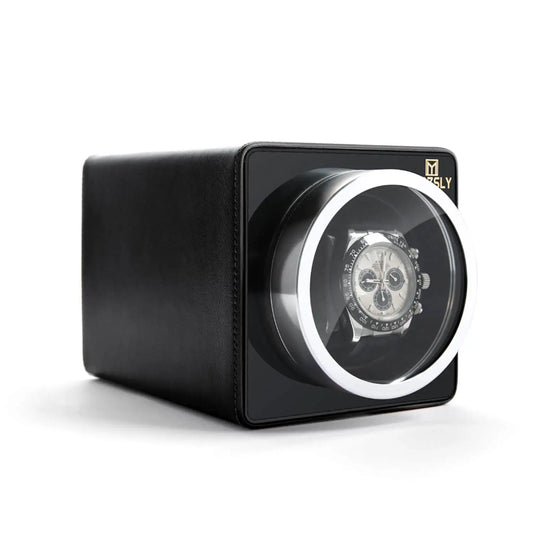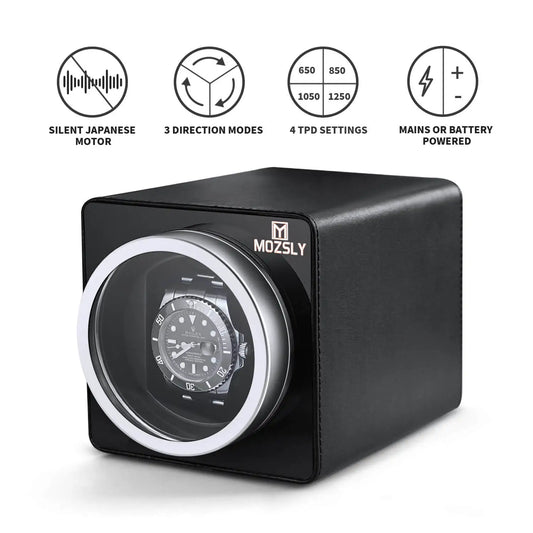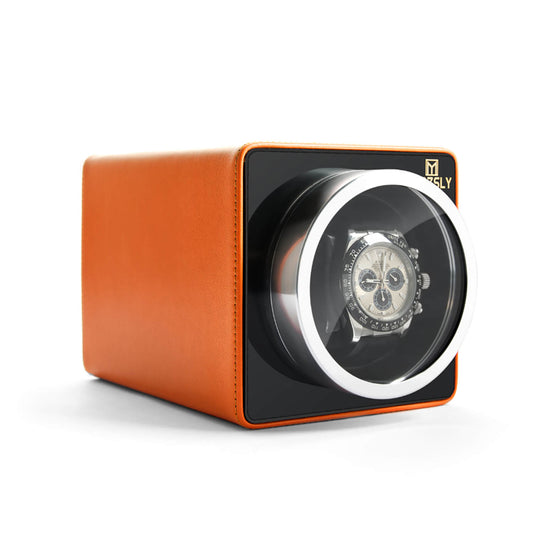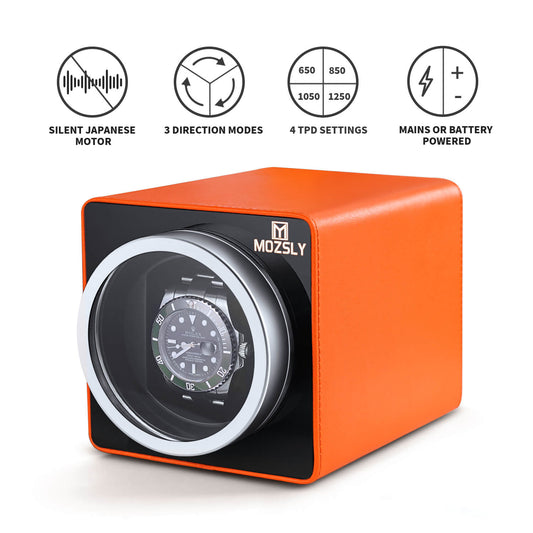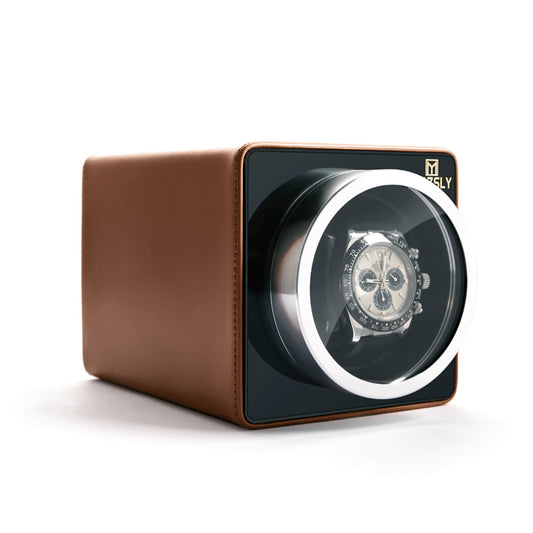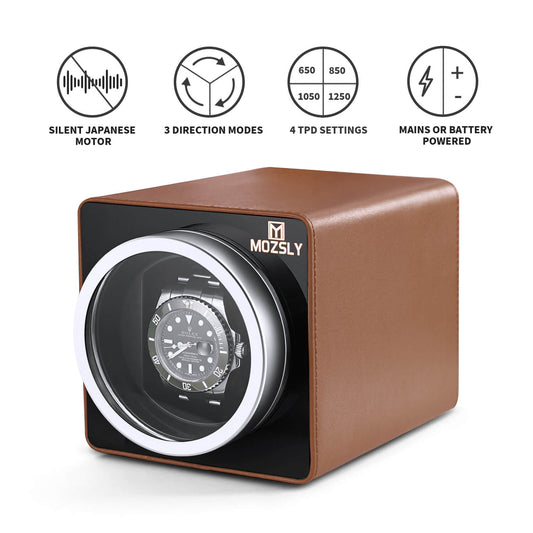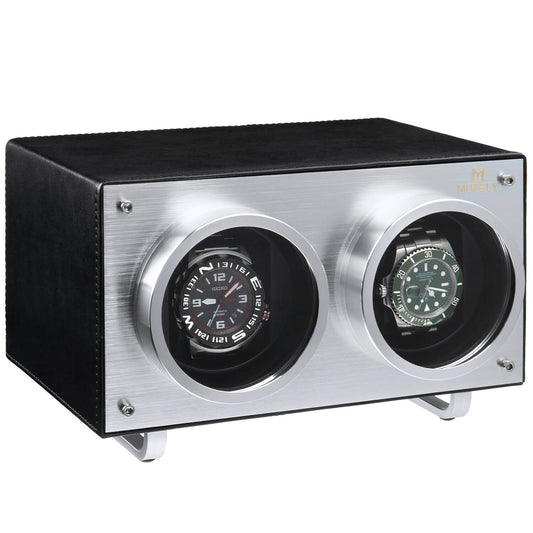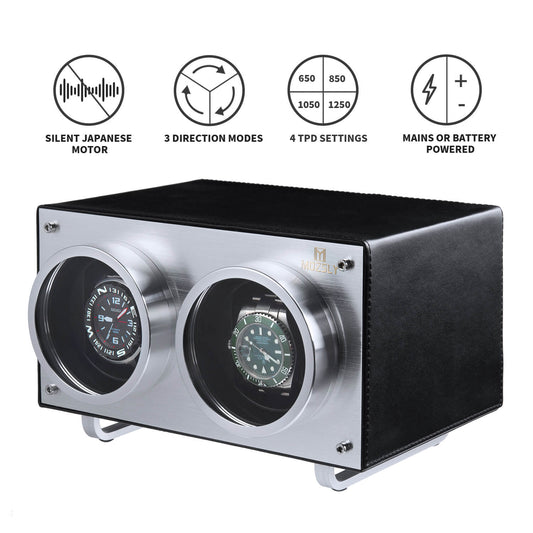How to Wind a Watch: Dos and Don'ts for Watch Winders
How to Wind a Watch: Dos and Don'ts for Watch Winders
With the renaissance and increasing popularity of automatic watches, the need for automatic watch winders has received more attention. Watch winders are most often recommended to collectors who happen to own watches with complicated calendar displays. Watch winders are useful but often misunderstood. Automatic watches have so many moving parts that some people think they are like cars and should be avoided from sitting dormant for long periods. Find out what you need to know about How to Wind a Watch: Dos and Don'ts for Watch Winders in our article.

What is a watch winder?
A watch winder is a device used to keep an automatic (also called self-winding) watch running when it is not being worn. Automatic watches work by winding themselves using a moving oscillating weight inside the watch. The weight oscillates or rotates when the watch is worn and turns the winding mechanism inside the watch. So, if the watch is not being worn, then it is no longer receiving power in this way and will be drained. While nearly all automatic watches can be wound by hand, this isn't always convenient. And so the concept of the automatic winder was born. Winders are becoming more popular as people collect more watches and want to keep the date and time settings when they are not wearing them!
How does a watch winder work?
Watch winders work by slowly turning an automatic watch on a side dial inside a special case or device, eliminating the need to wind the watch manually. As the winder turns, the oscillating weight inside the watch rotates, slowly winding up the mainspring.
Watch winders come in many different sizes. Some simpler models secure and wind one watch at a time. These single-watch winders are a great choice for the beginner collector looking to delve into the world of automatic watch winders.
For watch collectors who own multiple automatic watches and wish to wind them at any time, an automatic watch winder can hold multiple watches at once and have each watch spin on a separate dial. These winders cost much more than simple single-watch winders but are very handy for experienced collectors who don't want to wind the mainspring and set the time while wearing another watch.
While these watch winders are not essential, they can be a very useful tool in a watch enthusiast's arsenal.
Can a watch winder cause damage to a watch?
There is a lot of discussion about watch winders and whether they are safe to use. Will a watch winder damage a watch? If you look online, you may find different answers. Some people think that the winder will damage the watch, while others think that it will not be a problem.
The answer is usually no.
As long as the winder only turns a set number of times per day, called TPD (turns per day), there is very little risk of your watch being damaged. A common misconception is that the winder fully winds the mainspring of the watch, and the constant delivery of energy to the mainspring could cause damage.
First, the watch uses a slipper clutch to prevent overwinding. When fully wound, the slip clutch allows the winding mechanism to turn but does not further wind the mainspring. Second, if the watch winder is set to the correct TPD, then it will only rotate the watch just enough to keep the winding at the same level. In other words, the watch has only turned enough times to replenish the energy used to keep time since the last turn.
Just make sure the winder is compatible with your watch and can adjust the speed of rotation and you should be good to go.
It is also generally believed that a watch movement that is frequently used is more likely to be damaged than one that is rarely used. The answers here vary depending on the model and age of the watch and how well it has been cared for over the years.
But in general, watch movements run more smoothly when they are used a lot because this keeps the gears and other parts lubricated.
How does a watch winder wind a watch?
After purchasing a watch winder, you need to follow a few simple steps to start using it.
First, you cannot put a stopped watch in a watch barrel. Therefore, if your watch stops completely, it will need to be wound manually. Take the watch out of the case or wrist, find the crown, and unscrew it until it is in the first position, turn the crown clockwise about 20 to 40 turns, or until you feel resistance. When finished winding, push the crown back in.
Place the Watch
First, remove the cuff from the watch winder and start placing your watch on the cuff. You'll need to turn the cuff over, compress the foam, then snap the watch firmly onto the cuff and put the cuff back inside the winder.
Best TPD
You need to set the TPD ( Turns per day ), and for each watch, there is a magic number of revolutions per day to keep it running at its best. There is too little TPD and it cannot be fully wound. Too much and you might wear it out.
Generally, most winders will turn for 30 seconds to a minute and then stop. The exact break time for the winder is determined by the TPD setting. For example, your watch may need to be wound 10 times within 30 seconds. If 650 TPD is required to function properly, the automatic winder needs to be turned on 65 times a day. Since there are 1440 minutes in a day, you can divide 1440 by 65 to get 22. This means that the automatic winder will complete a full cycle every 22 minutes.
The manufacturer should specify in your manual the exact amount of TPD your watch requires, if you are unable to contact your watch manufacturer, you can try to look it up using the MOZSLY database. MOZSLY, a manufacturer of watch winders, maintains a comprehensive database of the direction of rotation of many watches. You can check it out here.
Direction of Rotation
You also need to set the turn direction. Most watches can be wound in both directions. But having a two-way watch winder means that every time the winder cycles, it turns in a different direction. Most watches are fine with a two-way winding mechanism. However, some watches have different specifications, such as clockwise or counterclockwise. A good watch winder will provide all three settings.
Start Winding
After setting the TPD and direction of rotation, it's time to turn on the winder. Over the next few days, be sure to check your watch regularly to make sure it's keeping the right time. If for some reason your watch is not keeping accurate time, you may need to adjust the TPD or orientation. If your watch doesn't run after making adjustments, you may need to take it to a trusted watchmaker.
- Since your winder will not wind a watch that is completely stopped, first manually wind your watch by turning the crown 20 to 40 times.
- Carefully place your watch in the winder, making sure it is fully seated on the stand. Then adjust the TPD to the lowest setting and select bidirectional rotation mode.
- Open the winder. For the next 48 hours or so, periodically check that the watch is still keeping the correct time. Generally speaking, the automatic mechanism has about 40 hours of reserve time after winding. If the time is still correct after two days, this is the right setup for you and you don't need to experiment anymore.
- However, if the time is wrong, increase to the next TPD setting and repeat the above process.
- If the time is correct after two days, you have found the correct setting.
- If the time is wrong, set the winder to clockwise only and repeat the process.
- If the time is still correct after two days, this is the correct setting for you.
- If the time is incorrect, set it to rotate counterclockwise only and repeat the process.
Do you need a watch winder?
If you have several watches that you like to alternate, having one of these tools would be a perfect idea. An automatic movement will most likely retain enough power to last a day or two between wearings and then be fully wound the next time it is taken off. If an automatic watch is left for too long, it will stop and need to correct the time the next time it is used.
For a watch that just displays the time and date, this isn't a big deal. But when you add extra complications like days and months, moon phases, etc., it can be a pain to reset everything every time you want to wear the watch.
This is the savior of watch winders. The watch winder securely holds the watch and rotates it from time to time throughout the day to ensure that enough energy is delivered to the mainspring to keep the movement running.
Even if the watch is safely placed in a watch winder, it must keep up with regular service. This maintenance is an effective way to check that the watch is still functioning well. There is no point in keeping a watch in a winding case if you ignore watch servicing. For example, if your watch has been around since four or five years ago, that's when you need to take it in for service. You're not doing the right job, you're dropping it and making the gears and pivots keep winding.
MOZSLY watch winder
Some watch winders have a simple on/off switch and continue to work, while others allow for some customization.
This means you can set the direction of the spin and how many revolutions per day (also known as TPD) they complete. This number can vary, but generally, you'll see options for around 600 to 1,000 rpm per day.
For some watches, it may be helpful to pair them with the winder and TPD settings that best suit their automatic movement. Winders that accommodate multiple watches allow you to set the direction and TPD for each winder, helping you wind your collection to perfection. While there are direction and TPD options, most automatic watches cannot be damaged by overwinding because they have a slip clutch that prevents the mainspring from being overwound.
If you only have one watch, it's unlikely you'll need a watch winder. Unless you only wear the watch occasionally, it has enough power to last two or three days without it. Likewise, if you own several watches but rotate between them frequently, you will rarely need a watch winder.
However, if you own an automatic watch but only wear it once in a while, a winder might be a good idea – especially if it has multiple complications that need to be reset every time you want to wear it.
Additionally, a watch winder can serve as a useful and safe way to store your watch when you are not using it. Many include a soft pad to secure the watch and a glass or plastic cover to protect the watch and keep it from attracting dust. The larger watch winder also makes a statement piece for your bedroom or dressing room, with compartments for multiple watches, accessories, and other jewelry. Finally, the largest watch winder (with a price tag to match) doubles as a safe for your most valuables.

What to look for in a watch winder
Watch winders come in many forms, each with its benefits and aesthetics. Your purchase should depend on your collection and the attributes of each of your watches. You should know what to look for in a winding machine? Finding your first watch winder can be a daunting task, with prices for the cheapest and most expensive watch winders varying widely.
There are several different specifications to consider. Since the essence of a winder is to take care of your watch, the most intuitive winder is the most suitable for the actual wearing of an automatic watch. For most watches, you will want to look at the following specifications when choosing a watch winder:
Program Settings: This is one of the most important aspects of responsible watch winder ownership. You'll want to make sure the winder has a variety of options for revolutions per day (TPD); a range between ~650 and ~1800 revolutions per day should handle almost any automatic. You want a winder that can rotate clockwise, counterclockwise, or bi-directionally so that it meets all the potential needs of your watch.
Power Supply: You need a reliable power source to power your watch winder, because if the battery on the winder dies without your knowledge, then the purpose of storing the watch in the winder is completely defeated. Most watch winders have a power adapter and must always be plugged in, requiring them to be near a power outlet. Battery-powered watch winders are also available, but most usually require frequent battery changes, and most users find themselves unaware of this until they discover their watch is dead.
In MOZSLY, even our entry-level single watch winders, such as single watch winders and double watch winders series are also equipped with AC power (100-240V) or 2 AA batteries, and watch winders can be connected in series to rotate your multiple watches! This means you can proudly display your watches wherever you like without being tethered to your nearest electrical outlet, or store them safely in a safe where they will stay the next time you're out and about.Design Style: With the number of beautiful watches on the market, the options for watch winding storage are certainly limitless, leather, wood, metal, carbon fiber piano lacquer, red, purple, and green abound. Winders tailored to fit the design of a particular watch model are readily available.
Noise Level : While other build quality factors will often show their flaws over time, one of the first things that can cause frustration is the noise a watch winder makes. Many cheap-watch winders will have noisy motors with minimal sound attenuation, which can be irritating. The most common reason people who buy other watch winders online upgrade to our silent high-end watch winders.

WATCH WINDERS IN THE MOZSLY STORE
As watch winders have become more common over the past three decades, they have evolved in several ways. You can easily order an unbranded cable winder off the Internet for $40, just as you can order it from a world-renowned luxury brand for $2,000 or more. Ordering the cheapest option has obvious and documented problems that will most likely end up damaging your watch (if the winder lasts that long). That doesn't mean you have to spend a lot of money to get a quality cord winder that lasts a long time; in fact, many of the cord winders we've personally found useful over the years are under $1,000.
A high-quality watch winder should be made of the highest quality materials,MOZSLY watch winders, are not only for our timepieces but also for yours. All of our watch winders are programmable, feature high-quality motors from Mabuchi, and are handcrafted from the finest leathers and the highest quality materials. Our collection of watch winders from China combines quality, design, and flair with impeccable quality! A quality watch winder should also be backed by a long warranty. These watch winders come with a 3-year warranty.
WATCH WINDERS IN THE MOZSLY STORE, a company based in China that is considered one of the highest-quality manufacturers in the world. Starting at $89.99, the MOZSLY Winder is MOZSLY's entry-level watch winder, but it's by no means a basic option. Each winder is made of wood and is beautifully crafted with multiple layers of colorful paint. From midnight black and glacier white to admiral blue and bolder hues like crimson, green, and more, you'll be able to find a seamless match for your watch collection. The winding mechanism is known for being exceptionally quiet and can be easily adjusted to best suit the needs of your watch.

OUR INSPIRATION
MOZSLY was founded by Sheldon, an avid watch collector who was frustrated with the market being full of expensive watch winders. From this, Sheldon set out to create a line of watch winders that would not only wind a watch wound and be ready to wear, but also add a touch of luxury to the whole experience of wearing a watch.
OUR PURSUIT
MOZSLY watches winders pay special attention to detail to ensure that each product is a work of art in itself. Our team of 20 skilled craftsmen makes each winder with the utmost care and precision. We are obsessed with quality and strive to exceed our customers’ expectations with every product we make.
ALWAYS READY FOR YOU
At MOZSLY, we believe that time is a precious commodity and that our customers deserve the best. Our mission is to enhance the experience of wearing a watch for collectors and enthusiasts everywhere. With MOZSLY, you can be confident that your timepiece will always be ready to wear and remain in pristine condition for years to come.



